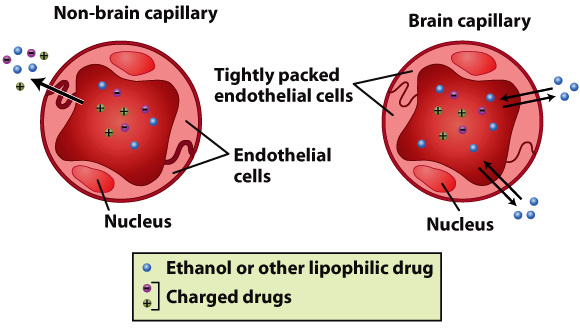Alcohol leaves the capillaries to enter tissues, including the brain
As ethanol circulates throughout the bloodstream, the concentration gradient is in the direction that favors movement of ethanol from the capillaries through interstitial spaces and into cells of different organs. The loosely packed endothelial cells and the fenestrae allow ethanol to move easily out of the capillaries.
There is an exception to the “leaky” capillaries—and that’s in the brain. There, the capillaries do not have fenestrae and the endothelial cells are tightly packed together. This construction helps to form a barrier (the “blood-brain-barrier”) to drugs and other molecules that are charged or polar, preventing them from entering the brain itself. Because alcohol is slightly lipophilic, it can still diffuse across the brain endothelial cell membrane, with the concentration gradient to get into (or out of) the brain. In the brain, alcohol interferes with brain cell function to cause intoxication (and a host of other things!).
 Figure 1.8 Capillaries in the brain are an exception; the endothelial cells are tightly packed and do not contain fenestrae or holes. Because ethanol is slightly lipophilic, it can still diffuse through the lipid bilayer of these endothelial cells.
Figure 1.8 Capillaries in the brain are an exception; the endothelial cells are tightly packed and do not contain fenestrae or holes. Because ethanol is slightly lipophilic, it can still diffuse through the lipid bilayer of these endothelial cells.
Learn more about the blood-brain-barrier.
Alcohol distributes into water spaces, not fat
Because ethanol is soluble in water it moves into water spaces throughout the body. The water spaces include the bloodstream, extracellular spaces, and intracellular spaces. However, ethanol does not accumulate in adipose tissue (fat) because it has little non-polar character and it prefers to reside in water. So it is restricted to a finite “water” volume within the body. This water volume, called “total body water” differs between females and males. In general, females have a higher percentage of their body mass as fat, and a lower percentage as water compared to males (Figure 1.9).

Figure 1.9 Females have a lower percentage of water (and higher percentage of fat) in the body. This means females will have a higher BAC compared to males if they drink the same amount of alcohol.
On average, the total body water in females is 55% of their body mass compared with that in males, which is 68%. Of course there are some exceptions—a lean female athlete would be expected to have a higher percent of total body water than an obese male.
As the percentage of body fat increases, the BAC increases—this is because the total body water is lower, and that means that the alcohol is confined to this smaller volume. This relationship is familiar—concentration can be expressed as mass per unit volume (C = M/V). Concentration is indirectly proportional to volume—the smaller the water volume in the body, the higher the concentration of alcohol in the water spaces.
The higher BAC in females puts them at greater risk of intoxication compared to males, since more alcohol reaches the brain.
Learn more about how alcohol produces intoxication.